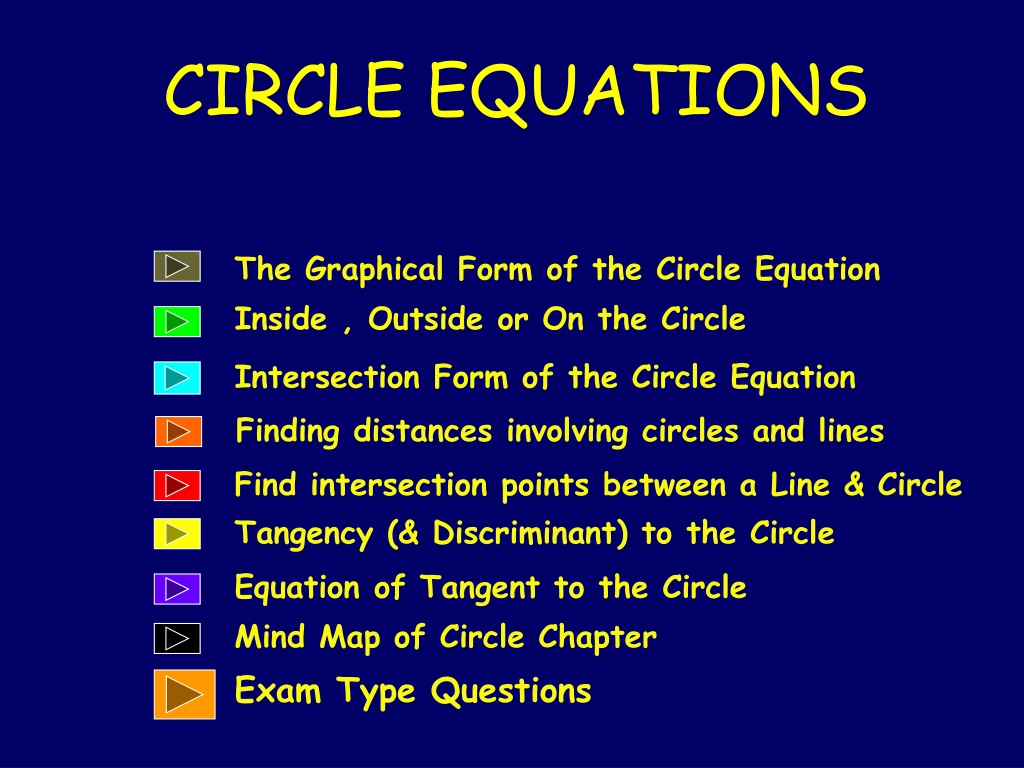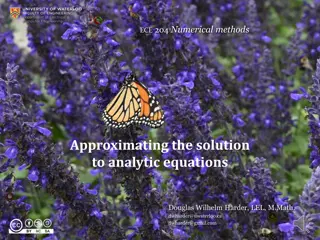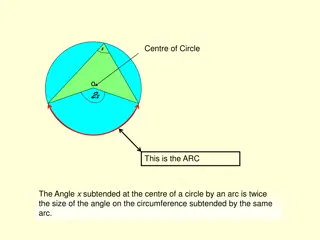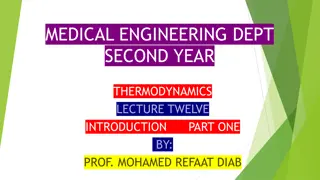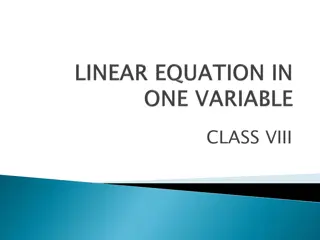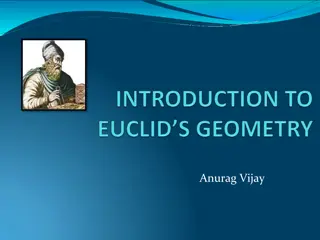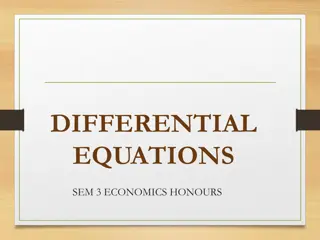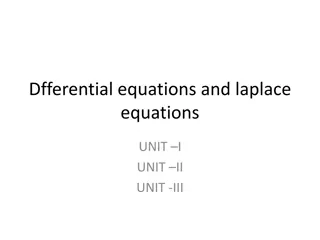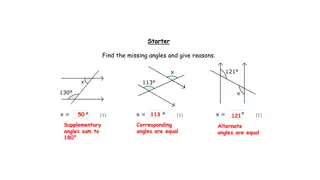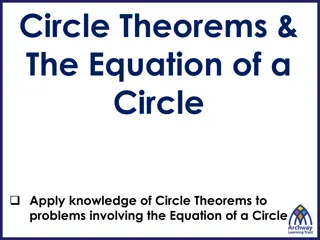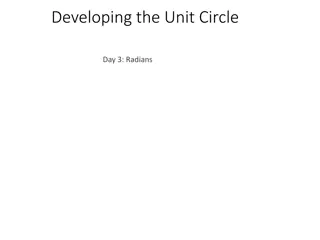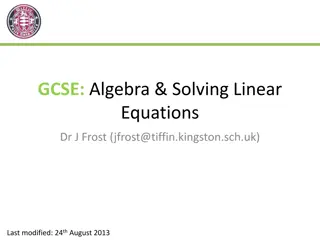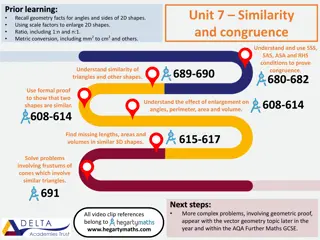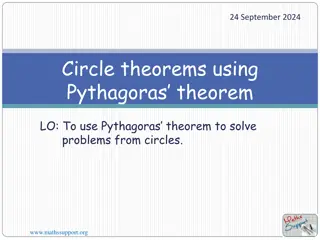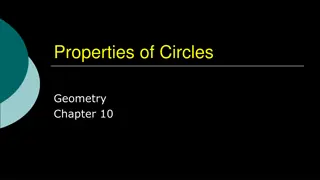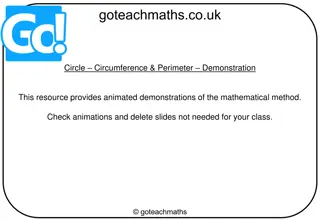Circle Equations and Geometry Concepts
Circle equations, graphical representation, intersection forms, tangency, and finding distances involving circles and lines. Learn how to determine centers, radii, and equations of circles. Examples and diagrams included to enhance understanding.
Download Presentation

Please find below an Image/Link to download the presentation.
The content on the website is provided AS IS for your information and personal use only. It may not be sold, licensed, or shared on other websites without obtaining consent from the author.If you encounter any issues during the download, it is possible that the publisher has removed the file from their server.
You are allowed to download the files provided on this website for personal or commercial use, subject to the condition that they are used lawfully. All files are the property of their respective owners.
The content on the website is provided AS IS for your information and personal use only. It may not be sold, licensed, or shared on other websites without obtaining consent from the author.
E N D
Presentation Transcript
CIRCLE EQUATIONS The Graphical Form of the Circle Equation Inside , Outside or On the Circle Intersection Form of the Circle Equation Finding distances involving circles and lines Find intersection points between a Line & Circle Tangency (& Discriminant) to the Circle Equation of Tangent to the Circle Mind Map of Circle Chapter Exam Type Questions
The Circle The distance from (a,b) to (x,y) is given by r2 = (x - a)2 + (y - b)2 Proof (x , y) r (y b) (a , b) (x , b) By Pythagoras (x a) r2 = (x - a)2 + (y - b)2
Equation of a Circle Centre at the Origin OP has length r r is the radius of the circle ByPythagoras Theorem y-axis c + = 2 2 2 ( ) x y r b a a2+b2=c2 P(x,y) y r x x-axis O 3
The Circle Find the centre and radius of the circles below x2 + y2 = 7 centre (0,0) & radius = 7 x2 + y2 = 1/9 centre (0,0) & radius = 1/3
General Equation of a Circle y-axis CP has length r r is the radius of the circle with centre (a,b) P(x,y) y r y-b ByPythagoras Theorem + Centre C(a,b) C(a,b) b = 2 2 2 x a y b r ( ) ( ) x-a O a x x-axis c b To find the equation of a circle you need to know a Centre C (a,b) and radius r OR a2+b2=c2 Centre C (a,b) and point on the circumference of the circle 5
The Circle Examples (x-2)2 + (y-5)2 = 49centre (2,5) radius = 7 (x+5)2 + (y-1)2 = 13 centre (-5,1) radius = 13 centre (3,0) radius = 20 = 4 X 5 (x-3)2 + y2 = 20 = 2 5 Centre (2,-3) & radius = 10 NAB Equation is (x-2)2 + (y+3)2 = 100 r2 = 2 3 X 2 3 = 4 9 = 12 Centre (0,6) & radius = 2 3 Equation is x2 + (y-6)2 = 12
The Circle Example P Find the equation of the circle that has PQ as diameter where P is(5,2) and Q is(-1,-6). C Q C is ((5+(-1))/2,(2+(-6))/2) = (2,-2) = (a,b) = 9 + 16 = 25 = r2 CP2 = (5-2)2 + (2+2)2 Using (x-a)2 + (y-b)2 = r2 Equation is (x-2)2 + (y+2)2 = 25
The Circle Example Two circles are concentric. (ie have same centre) The larger has equation (x+3)2 + (y-5)2 = 12 The radius of the smaller is half that of the larger. Find its equation. Using (x-a)2 + (y-b)2 = r2 Centres are at (-3, 5) Larger radius = 12 = 4 X 3 = 2 3 Smaller radius = 3 so r2 = 3 Required equation is (x+3)2 + (y-5)2 = 3
Inside / Outside or On Circumference When a circle has equation (x-a)2 + (y-b)2 = r2 If (x,y) lies on the circumference then (x-a)2 + (y-b)2 = r2 If (x,y) lies inside the circumference then (x-a)2 + (y-b)2 < r2 If (x,y) lies outside the circumference then (x-a)2 + (y-b)2 > r2 Taking the circle (x+1)2 + (y-4)2 = 100 Determine where the following points lie; Example K(-7,12) , L(10,5) , M(4,9)
Inside / Outside or On Circumference At K(-7,12) (x+1)2 + (y-4)2 = (-7+1)2 + (12-4)2 = (-6)2 + 82= 36 + 64 = 100 So point K is on the circumference. At L(10,5) (x+1)2 + (y-4)2 =(10+1)2 + (5-4)2 =112 + 12= 121 + 1 = 122 > 100 So point L is outside the circumference. At M(4,9) (x+1)2 + (y-4)2 =(4+1)2 + (9-4)2 = 52 + 52= 25 + 25 = 50 < 100 So point M is inside the circumference.
Intersection Form of the Circle Equation Centre C(a,b) Radiusr 1. + = 2 2 2 x a y b r ( ) ( ) + = 2 x a x a y b y b r ( )( ) ( )( ) c a = b 2 r 2 2 2 = + + + + = 2 2 2 2 2 x xa a y yb b r ( 2 ) ( 2 ) c (-g) 2 = ( f) 2 r 2 2 + + + + = 2 2 2 2 2 x y xa yb a b r 2 2 c g f r 2 + r g f c 2 2 2 = + + + + = 2 2 2 2 2 2 2 0 x y ax by a b r r g f c 2 2 = + Let g - = a, f -b, c a = b r 2 2 2 = + Radiusr 2. + + + + = 2 2 x y gx fy c 2 2 0 Centre C(-g,-f) = + 2 2 g f c 2-Mar-25 www.mathsrevision.com 11
Equation x2 + y2 + 2gx + 2fy + c = 0 Example Write the equation (x-5)2 + (y+3)2 = 49 without brackets. (x-5)2 + (y+3)2 = 49 (x-5)(x+5) + (y+3)(y+3) = 49 x2 - 10x + 25 + y2 + 6y + 9 49 = 0 x2 + y2 - 10x + 6y -15 = 0 This takes the form given above where 2g = -10 , 2f = 6 and c = -15
Equation x2 + y2 + 2gx + 2fy + c = 0 Example Show that the equation x2 + y2 - 6x + 2y - 71 = 0 represents a circle and find the centre and radius. x2 + y2 - 6x + 2y - 71 = 0 x2 - 6x + y2 + 2y = 71 (x2 - 6x + 9) + (y2 + 2y + 1) = 71 + 9 + 1 (x - 3)2 + (y + 1)2 = 81 This is now in the form (x-a)2 + (y-b)2 = r2 So represents a circle with centre (3,-1) and radius = 9
Equation x2 + y2 + 2gx + 2fy + c = 0 Example We now have 2 ways on finding the centre and radius of a circle depending on the form we have. x2 + y2 - 10x + 6y - 15 = 0 2g = -10 g = -5 c = -15 2f = 6 f = 3 radius = (g2 + f2 c) = (25 + 9 (-15)) = 49 = 7 centre = (-g,-f) = (5,-3)
Equation x2 + y2 + 2gx + 2fy + c = 0 Example x2 + y2 - 6x + 2y - 71 = 0 2g = -6 g = -3 c = -71 2f = 2 f = 1 centre = (-g,-f) = (3,-1) radius = (g2 + f2 c) = (9 + 1 (-71)) = 81 = 9
Equation x2 + y2 + 2gx + 2fy + c = 0 Example Find the centre & radius of x2 + y2 - 10x + 4y - 5 = 0 x2 + y2 - 10x + 4y - 5 = 0 NAB c = -5 2g = -10 g = -5 2f = 4 f = 2 radius = (g2 + f2 c) = (25 + 4 (-5)) = 34 centre = (-g,-f) = (5,-2)
Equation x2 + y2 + 2gx + 2fy + c = 0 Example The circle x2 + y2 - 10x - 8y + 7 = 0 cuts the y- axis at A & B. Find the length of AB. At A & B x = 0 so the equation becomes Y y2 - 8y + 7 = 0 (y 1)(y 7) = 0 y = 1 or y = 7 A B X A is (0,7) & B is (0,1) So AB = 6 units
Application of Circle Theory Frosty the Snowman s lower body section can be represented by the equation x2 + y2 6x + 2y 26 = 0 His middle section is the same size as the lower but his head is only 1/3 the size of the other two sections. Find the equation of his head ! x2 + y2 6x + 2y 26 = 0 radius = (g2 + f2 c) = (9 + 1 + 26) = 36 = 6 2g = -6 g = -3 2f = 2 f = 1 c = -26 centre = (-g,-f) = (3,-1)
Working with Distances (3,19) radius of head = 1/3 of 6 = 2 2 6 Using (x-a)2 + (y-b)2 = r2 (3,11) Equation is (x-3)2 + (y-19)2 = 4 6 6 (3,-1)
Working with Distances Example By considering centres and radii prove that the following two circles touch each other. Circle 1 x2 + y2 + 4x - 2y - 5 = 0 Circle 2 x2 + y2 - 20x + 6y + 19 = 0 Circle 2 2g = -20 so g = -10 Circle 1 2g = 4 so g = 2 2f = -2 so f = -1 2f = 6 so f = 3 c = -5 c = 19 centre = (-g, -f) radius = (g2 + f2 c) = (4 + 1 + 5) = 10 = (-2,1) centre = (-g, -f) radius = (g2 + f2 c) = (100 + 9 19) = 90 = 9 X 10= 3 10 = (10,-3)
Working with Distances If d is the distance between the centres then d2 = (x2-x1)2 + (y2-y1)2= (10+2)2 + (-3-1)2= 144 + 16 = 160 d = 160 = 16 X 10 = 4 10 r2 r1 radius1 + radius2 = 10 + 3 10 = 4 10 = distance between centres It now follows that the circles touch !
Intersection of Lines & Circles There are 3 possible scenarios 1 point of contact line is a tangent discriminant 0 points of contact discriminant 2 points of contact discriminant (b2- 4ac < 0) (b2- 4ac > 0) (b2- 4ac = 0) To determine where the line and circle meet we use simultaneous equations and the discriminant tells us how many solutions we have.
Intersection of Lines & Circles Example Find where the line y = 2x + 1 meets the circle (x 4)2 + (y + 1)2 = 20 and comment on the answer Replace y by 2x + 1 in the circle equation (x 4)2 + (y + 1)2 = 20 becomes (x 4)2 + (2x + 1 + 1)2 = 20 (x 4)2 + (2x + 2)2 = 20 x 2 8x + 16 + 4x 2 + 8x + 4 = 20 5x 2 = 0 x 2 = 0 x = 0 one solution tangent point Using y = 2x + 1, if x = 0 then y = 1 Point of contact is (0,1)
Intersection of Lines & Circles Example Find where the line y = 2x + 6 meets the circle x2 + y2 + 10x 2y + 1 = 0 Replace y by 2x + 6 in the circle equation x2 + y2 + 10x 2y + 1 = 0 becomes x2 + (2x + 6)2 + 10x 2(2x + 6) + 1 = 0 x 2 + 4x2 + 24x + 36 + 10x 4x - 12 + 1 = 0 5x2 + 30x + 25 = 0 x 2 + 6x + 5 = 0 (x + 5)(x + 1) = 0 x = -5 or x = -1 ( 5 ) Points of contact are (-5,-4) and (-1,4). Using y = 2x + 6 if x = -5 then y = -4 if x = -1 then y = 4
Tangency Example Prove that the line 2x + y = 19 is a tangent to the circle x2 + y2 - 6x + 4y - 32 = 0 , and also find the point of contact. 2x + y = 19 so y = 19 2x Replace y by (19 2x) in the circle equation. x2 + y2 - 6x + 4y - 32 = 0 x2 + (19 2x)2 - 6x + 4(19 2x) - 32 = 0 x2 + 361 76x + 4x2 - 6x + 76 8x - 32 = 0 NAB Using y = 19 2x If x = 9 then y = 1 Point of contact is (9,1) 5x2 90x + 405 = 0 ( 5) x2 18x + 81 = 0 (x 9)(x 9) = 0 x = 9 only one solution hence tangent
Using Discriminants At the line x2 18x + 81 = 0 we can also show there is only one solution by showing that the discriminant is zero. For x2 18x + 81 = 0 , a =1, b = -18 and c = 9 So b2 4ac = (-18)2 4 X 1 X 81 = 364 - 364= 0 Since disc = 0 then equation has only one root so there is only one point of contact so line is a tangent. The next example uses discriminants in a slightly different way.
Using Discriminants Example Find the equations of the tangents to the circle x2 + y2 4y 6 = 0 from the point (0,-8). x2 + y2 4y 6 = 0 2g = 0 so g = 0 2f = -4 so f = -2 Centre is (0,2) Y x2 + y2 4y 6 = 0 Each tangent takes the form y = mx -8 Replace y by (mx 8) in the circle equation to find where they meet. This gives us (0,2) x2 + (mx 8)2 4(mx 8) 6 = 0 x2 + m2x2 16mx + 64 4mx + 32 6 = 0 (m2+ 1)x2 20mx + 90 = 0 -8 In this quadratic a = (m2+ 1) b = -20m c =90
Tangency For tangency we need discriminate = 0 b2 4ac = 0 (-20m)2 4 X (m2+ 1) X 90 = 0 400m2 360m2 360 = 0 40m2 360 = 0 40m2 = 360 m = -3 or 3 m2 = 9 So the two tangents are y = -3x 8 and y = 3x - 8 and the gradients are reflected in the symmetry of the diagram.
Equations of Tangents NB: At the point of contact a tangent and radius/diameter are perpendicular. Tangent radius This means we make use of m1m2 = -1.
Equations of Tangents Example Prove that the point (-4,4) lies on the circle x2 + y2 12y + 16 = 0 Find the equation of the tangent here. NAB At (-4,4) x2 + y2 12y + 16 = 16 + 16 48 + 16 = 0 So (-4,4) must lie on the circle. x2 + y2 12y + 16 = 0 2g = 0 so g = 0 2f = -12 so f = -6 Centre is (-g,-f) = (0,6)
Equations of Tangents Gradient of radius =y2 y1 = (6 4)/(0 + 4) (0,6) x2 x1 = 2/4 (-4,4) = 1/2 So gradient of tangent = -2 Using y b = m(x a) We get y 4 = -2(x + 4) y 4 = -2x - 8 ( m1m2 = -1) y = -2x - 4
Quadratic Theory Discriminant Graph sketching = + 2 2 r g f c - ac 2 Used for N 4 0 ct n io b Move the circle from the origin a units to the right b units upwards intersection problems between circles and lines interse O - ac 2 2 pt 4 0 b x y + + + + = 2 22 of intersecti s on 2 0 g x f y c Centre (-g,-f) Centre (a,b) Factorisation The Circle - ac = 2 line is a tan 4 0 ge t b ( ) ( ) x a + = 2 2 2 y b r n Special case Pythagoras Theorem Rotated through 360 deg. Straight line Theory + = 2 2 2 x y r Two circles touch internally if the distance C ( C = Perpendicular equation m m Centre (0,0) Two circles touch externally if the distance C C = ) r r = 1 1 2 2 1 1 2 ( ) + r r Mind Map For Higher Maths Created by Mr. Lafferty 1 2 1 2 Distance formula ( y y = Topic : The Circle ) ( + ) x x 2 2 1 2 CC 2 1 2 1
Find the equation of the circle with centre ( 3, 4) and passing through the origin. r = 5 Find radius (distance formula): ( 3, 4) You know the centre: + + = 2 2 ( 3) ( 4) 25 x y Write down equation: Previous Next Quit Quit
+ + + + = 2 2 Explain why the equation 2 3 5 0 x y x y does not represent a circle. 1. Coefficients of x2 and y2 must be the same. Consider the 2 conditions + 2 2 . . ie g 0 f c 2. Radius must be > 0 3 2 = = ( 1, g f Calculate g and f: ) 2 3 2 1 4 + 2 2 ( 1) + + 2 g f c 5 1 2 5 0 Evaluate + + 2 2 2 2 Deduction: 0 g f c so g f c not real Equation does not represent a circle Previous Next Quit Quit
Find the equation of the circle which has P(2, 1) and Q(4, 5) as the end points of a diameter. Q(4, 5) C Make a sketch P(-2, -1) (1, 2) Calculate mid-point for centre: r = 18 Calculate radius CQ: ( ) ( ) 2 2 + = 1 2 18 x y Write down equation; Previous Next Quit Quit
Find the equation of the tangent at the point (3, 4) on the circle + + = 2 2 2 4 15 0 x y x y P(3, 4) ( 1, 2) Calculate centre of circle: Make a sketch O(-1, 2) 1 2 m = Calculate gradient of OP (radius to tangent) m = 2 Gradient of tangent: + = 2 10 y x Equation of tangent: Previous Next Quit Quit
The point P(2, 3) lies on the circle + + = 2 2 ( 1) ( 1) 13 x y Find the equation of the tangent at P. P(2, 3) ( 1,1) Find centre of circle: Make a sketch O(-1, 1) 2 3 m = Calculate gradient of radius to tangent 3 2 m = Gradient of tangent: + = 2 3 12 y x Equation of tangent: Previous Next Quit Quit
O, A and B are the centres of the three circles shown in the diagram. The two outer circles are congruent, each touches the smallest circle. Circle centre A has equation ( ) 12 x ( ) The three centres lie on a parabola whose axis of symmetry 2 2 + + = 5 25 y is shown the by broken line through A. a) i) State coordinates of A and find length of line OA. = + ( ) y px x q Find p and q. ii) Hence find the equation of the circle with centre B. b) The equation of the parabola can be written in the form 13 A(12, 5) Find OA (Distance formula) A is centre of small circle 5 B(24, 0) Find radius of circle A from eqn. Use symmetry, find B 13 5 8 = + = 2 2 ( 24) 64 x y Find radius of circle B Eqn. of B = + 0 = 24 (24 5 12 (12 ) p q Points O, A, B lie on parabola subst. A and B in turn 5 = = 144, 24 p q Solve: + ) p q Previous Next Quit Quit
Circle P has equation Circle Q has centre (2, 1) and radius 22. 8 10 9 x y x y + + = 2 2 0 a) i) Show that the radius of circle P is 4 2 ii) Hence show that circles P and Q touch. b) Find the equation of the tangent to circle Q at the point ( 4, 1) c) The tangent in (b) intersects circle P in two points. Find the x co-ordinates of the points of 3 a b intersection, expressing your answers in the form (4, 5) + = = 2 2 Find centre of circle P: Find radius of circle :P: 4 5 9 32 4 2 = 72 6 2 Find distance between centres = sum of radii, so circles touch m = Deduction: m= 1 1 Gradient tangent at Q: Gradient of radius of Q to tangent: = + 5 y x Equation of tangent: + + = 2 2 2 2 3 8 10 9 0 x y y x y Soln: Solve eqns. simultaneously = + 5 x Previous Next Quit Quit
+ + ky k = 2 2 4 2 2 0 x y kx For what range of values of k does the equation represent a circle ? = = = 2 , k , 2 g f k c k Determine g, f and c: ( 2 ) + 2 2 ( 2) 0 k k k + 2 2 Put in values 0 g f c State condition + + Need to see the position 2 Simplify 5 2 0 k k of the parabola Complete the square ( ( ( 10 ) 1 5 Minimum value is195 1 + + 2 5 2 k k when k = 100 10 ) 2 1 1 + + This is positive, so graph is: 5 2 k 10 100 Expression is positive for all k: ) 2 1 195 100 + + 5 k So equation is a circle for all values of k. Previous Next Quit Quit
+ + + = 2 2 6 4 0 x y x y c For what range of values of c does the equation represent a circle ? = = = 3, 2, ? g f c Determine g, f and c: ( 2) + 2 2 3 0 c + 2 2 Put in values 0 g f c State condition 9 4 + 0 c Simplify c 13 Re-arrange: Previous Next Quit Quit
+ + = 2 2 ( 3) ( 2) 25 The circle shown has equation x y Find the equation of the tangent at the point (6, 2). (3, 2) Calculate centre of circle: 4 3 m = Calculate gradient of radius (to tangent) 3 4 m = Gradient of tangent: + = 4 3 26 y x Equation of tangent: Previous Next Quit Quit
When newspapers were printed by lithograph, the newsprint had to run over three rollers, illustrated in the diagram by 3 circles. The centres A, B and C of the three circles are collinear. The equations of the circumferences of the outer circles are 2 2 ( 12) ( 15) 25 and ( x y + + + = + = 2 2 24) ( 12, 15) ( 12) 100 x y (24, 12) = 5 r Find the equation of the central circle. Find centre and radius of Circle A 25 r = (24,12) 10 27 B Find centre and radius of Circle C 20 + 30 25 45 x = 2 2 36 27 45 Find distance AB (distance formula) (-12, -15) 36 45 (5 10) 25 45 Equation of B ( + = 15 Find diameter of circle B so radius of B = 27 15, = = 36 20 ( + Use proportion to find B relative to C ) 3 + ) 2 2 = 4 225 y (4, 3) Centre of B Previous Next Quit Quit
